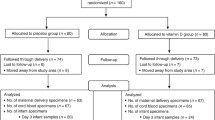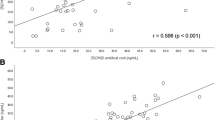Abstract
Objective
To determine 25-hydroxyvitamin D (25OHD) levels in pregnant women at 28 weeks and supplement based on these levels and check maternal and neonatal levels after delivery at term.
Design
This is a prospective observational study wherein pregnant women aged 18–35 years received cholecalciferol from 28 weeks till delivery at term. Women with 25OHD levels ≥ 75 nmol/L received 12.5 μg/day, those with levels 50–74.9 nmol/L received 100 μg/day and those with levels ≤ 49.9 nmol/L received 1500 μg/week.
Results
Of 555, 532 women (95.8%) completed the study. Of 532, 77 (14.5%) women had 25OHD ≥ 75 nmol/L at 28 weeks; 34/77 (44.15%) became deficient at term, and the mean 25OHD reduced from 99 ± 29.9 to 77 ± 30.4 nmol/L (p < 0.0001). One hundred and seventy-one women had 25OHD 50–74.9 nmol/L at 28 weeks; in 99 (57.89%), levels normalised at term, and mean 25OHD increased from 60.5 ± 7.5 to 78.2 ± 21.9 nmol/L (p < 0.0001). Two hundred and nineteen women had 25OHD 25–49.9 nmol/L at 28 weeks; in 135 (61.64%), levels normalised at term, and mean 25OHD increased from 36.6 ± 7.5 to 83.3 ± 32.7 nmol/L (p < 0.0001). Sixty-five women had 25OHD < 25 nmol/L at 28 weeks; In 39 (60.94%), levels normalised at term, and the mean 25OHD increased from 17.9 ± 5 to 80.6 ± 34.1 nmol/L (p < 0.0001). Seven neonates (1.3%) had cord blood ionised calcium values < 1 mmol/L, and all these had 25OHD < 50 nmol/L (mean 22.2 ± 2.5 nmol/L).
Conclusions
Standard 12.5 μg/day supplementation in women with normal 25OHD levels at 28 weeks leads to deficiency in 44% women by term. Cholecalciferol in doses of 100 μg/day and 1500 μg/week leads to a significant increase in 25OHD levels in vitamin D-deficient pregnant women though nearly 40% may still have deficient levels at term along with their newborns. Only 1.3% of newborns had hypocalcaemia.

Similar content being viewed by others
References
Kumar P, Shenoi A, Kumar RK, et al. Vitamin D deficiency among women in labor and cord blood of newborns. Indian Pediatr. 2015;52(6):530–1.
Sahu M, Bhatia V, Aggarwal A, et al. Vitamin D deficiency in rural girls and pregnant women despite abundant sunshine in northern India. Clin Endocrinol (Oxf). 2009;70(5):680–4.
Marwaha RK, Tandon N, Chopra S, et al. Vitamin D status in pregnant Indian women across trimesters and different seasons and its correlation with neonatal serum 25-hydroxyvitamin D levels. Br J Nutr. 2011;106(9):1383–9.
Whitehouse AJ, Holt BJ, Serralha M, et al. Maternal serum vitamin D levels during pregnancy and offspring neurocognitive development. Pediatrics. 2012;129(3):485–93.
Mithal A, Sanjay KS. Vitamin D supplementation in pregnancy. Indian J Endocrinol Metab. 2014;18(5):593–6.
Ross AC, Taylor CL, Yaktine AL, et al. Institute of medicine (US) committee to review dietary reference intakes for vitamin D and calcium. Dietary reference intakes for calcium and vitamin D. Washington: Natl Academies Press; 2011.
Holick MF, Binkley NC, Bischoff-Ferrari HA, et al. Endocrine Society. Evaluation, treatment, and prevention of vitamin D deficiency: an Endocrine Society clinical practice guideline. J Clin Endocrinol Metab. 2011;96(7):1911–30.
Hollis BW, Johnson D, Hulsey TC, et al. Vitamin D supplementation during pregnancy: double blind, randomized clinical trial of safety and effectiveness. J Bone Miner Res. 2011;26(10):2341–57.
Wagner CL, Greer FR. Prevention of rickets and vitamin D deficiency in infants, children, and adolescents. Pediatrics. 2008;122(5):1142–52.
Roth D, Mahmud A, Raqib R, et al. Pharmacokinetics of high-dose weekly oral vitamin D3 supplementation during the third trimester of pregnancy in Dhaka, Bangladesh. Nutrients. 2013;5(3):788–810.
Dawodu A, Akinbi H. Vitamin D nutrition in pregnancy: current opinion. Int J Womens Health. 2013;5:333–43.
Roth DE, Leung M, Mesfin E, et al. Vitamin D supplementation during pregnancy: state of the evidence from a systematic review of randomised trials. BMJ. 2017;29(359):j5237.
Hashemipour S, Lalooha F, Zahir Mirdamadi S, et al. Effect of vitamin D administration in vitamin D-deficient pregnant women on maternal and neonatal serum calcium and vitamin D concentrations: a randomised clinical trial. Br J Nutr. 2013;110(9):1611–6.
Hossain N, Kanani FH, Ramzan S, et al. Obstetric and neonatal outcomes of maternal vitamin D supplementation: results of an open-label, randomized controlled trial of antenatal vitamin D supplementation in Pakistani women. J Clin Endocrinol Metab. 2014;99(7):2448–55.
Kalra P, Das V, Agarwal A, et al. Effect of vitamin D supplementation during pregnancy on neonatal mineral homeostasis and anthropometry of the newborn and infant. Br J Nutr. 2012;108(6):1052–8.
Roth DE, Al Mahmud A, Raqib R, et al. Randomized placebo-controlled trial of high-dose prenatal third-trimester vitamin D3 supplementation in Bangladesh: the AViDD trial. Nutr J. 2013;12:47.
Dawodu A, Saadi HF, Bekdache G, et al. Randomized controlled trial (RCT) of vitamin D supplementation in pregnancy in a population with endemic vitamin D deficiency. J Clin Endocrinol Metab. 2013;98(6):2337–46.
Sablok A, Batra A, Thariani K, et al. Supplementation of vitamin D in pregnancy and its correlation with feto-maternal outcome. Clin Endocrinol (Oxf). 2015;83(4):536–41.
Grant CC, Stewart AW, Scragg R, et al. Vitamin D during pregnancy and infancy and infant serum 25-hydroxyvitamin D concentration. Pediatrics. 2014;133(1):143–53.
Sahu M, Das V, Aggarwal A, et al. Vitamin D replacement in pregnant women in rural north India: a pilot study. Eur J Clin Nutr. 2009;63(9):1157–9.
Sahoo SK, Katam KK, Das V, et al. Maternal vitamin D supplementation in pregnancy and offspring outcomes: a double-blind randomized placebo-controlled trial. J Bone Miner Metab. 2017;35(4):464–71.
Cipriani C, Romagnoli E, Pepe J, et al. Long-term bioavailability after a single oral or intramuscular administration of 600,000 IU of ergocalciferol or cholecalciferol: implications for treatment and prophylaxis. J Clin Endocrinol Metab. 2013;98(7):2709–15.
Cipriani C, Romagnoli E, Scillitani A, et al. Effect of a single oral dose of 600,000 IU of cholecalciferol on serum calciotropic hormones in young subjects with vitamin D deficiency: a prospective intervention study. J Clin Endocrinol Metab. 2010;95(10):4771–7.
Jones G. Pharmacokinetics of vitamin D toxicity. Am J Clin Nutr. 2008;88(2):582S–6S.
Abbasian M, Chaman R, Amiri M, et al. Vitamin D deficiency in pregnant women and their neonates. Glob J Health Sci. 2016;8(9):83–90.
Aly YF, El Koumi MA, Abd El Rahman RN. Impact of maternal vitamin D status during pregnancy on the prevalence of neonatal vitamin D deficiency. Pediatr Rep. 2013;5(1):24–7.
Harrington J, Perumal N, Al Mahmud A, et al. Vitamin D and fetal-neonatal calcium homeostasis: findings from a randomized controlled trial of high-dose antenatal vitamin D supplementation. Pediatr Res. 2014;76(3):302–9.
Acknowledgements
We thank all the nurses and hospital staff who helped in collecting the study samples.
Author information
Authors and Affiliations
Corresponding author
Ethics declarations
Conflict of interest
All authors declare that they have no conflict of interest
Human Rights
All procedures were in accordance with the ethical standards of the institutional research committee and with the 1964 Helsinki declaration and its later amendments and comparable ethical standards.
Informed Consent
Informed consent was obtained from all individual participants included in the study.
Additional information
Namrata Nagendra is a Junior Consultant, Department of Obstetrics and Gynaecology, Cloudnine Hospital, Jayanagar, Bangalore, India. Amitoj Chhina is an International Training Fellow, Department of Neonatology, Royal Victoria Infirmary, Newcastle upon Tyne, UK. Praveena Shenoi is a Consultant, Department of Obstetrics and Gynaecology, Cloudnine Hospital, Old Airport Road, Bangalore, India. Modhulika Bhattacharya is a Consultant, Department of Obstetrics and Gynaecology, Cloudnine Hospital, Old Airport Road, Bangalore, India. Arvind Shenoi is a Consultant, Department of Neonatology, Cloudnine Hospital, Old Airport Road, Bangalore, India. R Kishore Kumar is a Consultant, Department of Neonatology, Cloudnine Hospital, Jayanagar, Bangalore, India.
Rights and permissions
About this article
Cite this article
Nagendra, N., Chhina, A.S., Shenoi, P. et al. Observational Study of Third-Trimester Vitamin D3 Supplementation and Implications for Mothers and Neonates at Term. J Obstet Gynecol India 69 (Suppl 2), 89–94 (2019). https://doi.org/10.1007/s13224-018-1095-7
Received:
Accepted:
Published:
Issue Date:
DOI: https://doi.org/10.1007/s13224-018-1095-7




